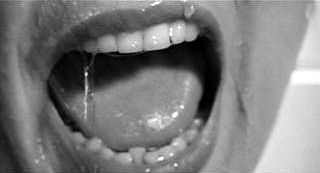
       by Iain Morrisson -- page 6 of 6 by Iain Morrisson -- page 6 of 6 |

From Psycho.
(© 1960 Shamley Productions, Inc. Renewed © 1988 Universal City Studios, Inc. All rights reserved.) |
Conclusion
For the shower scene in Psycho, Hitchcock's principles and methods can be traced to his earlier films--in which the principles and methods appear in isolation. Insofar as these features appear in more than one Hitchcock film, this analysis gives us some insights into what may be meant when somebody talks about a "Hitchcock" film.
Perhaps the most important of these principles is the principle of concealment. Unlike most of the slasher films that followed Psycho, Hitchcock's film contains no explicit violence. This is testament to the fact that Hitchcock understood something about the way in which human fear operates. To present the object of fear to our gaze is perhaps to negate its horror. There is another possible explanation for Hitchcock's refusal to present us with the horrific in a direct fashion. His films deal with people's reactions to horror, murder and injustice more than they deal with these subjects themselves. Crewe's concealed murder enriches our sympathy for Alice; she sees something horrible that we are not allowed see yet. Bruno's hidden murder of Miriam gives us a real sense of Bruno's mania, and Marion's death allows us a hint of what it is like to be savagely attacked. Hitchcock keeps his attention focused on character, and the degree to which his murders are hidden in these fims reflects the degree to which he wants his characters revealed.
GO TO NOTES
page 6 of 6
 
|